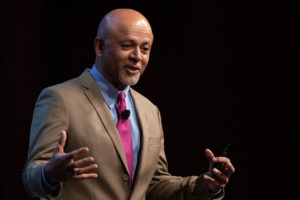A doctor’s ability to keenly observe a patient in detail is part of a ritual that has, for centuries, connected doctors with their patients. But this process is becoming endangered as the demands of Big Data threaten this critical component of the diagnostic process.

Abraham Verghese, M.D., MACP
“We are only trusting our numbers, not our eyes,” said Abraham Verghese, M.D., MACP, who is an acclaimed best-selling author, clinician, teacher, international lecturer and recipient of a 2015 National Humanities Medal from President Obama.
During Saturday’s Opening Session, “Humanistic Care in the Technological Age,” Dr. Verghese described how medicine has changed over the course of a few hundred years. From reviewing Joseph Bell’s incredible ability to observe the smallest details in his patients, to a more modern scenario in which a patient was intensely studied by doctors for 700 days, the result is staggering–the data collected for that one patient in 700 days was more than the entire contents of the Library of Congress.
“That was the moment I understood what big data really means,” Dr. Verghese said.
The demands of Big Data have divided doctors and patients, straining the physician-patient relationship. The requirement of constant documentation has big data competing with patients for a doctor’s attention. And in many cases, big data is winning.
To illustrate the importance of the doctor-patient relationship, Dr. Verghese used the painting “The Doctor,” which was created by Luke Fildes in 1891. In the painting, a doctor is caring for a very sick child. The mother is praying. The father is looking to the doctor for answers. The doctor’s singular focus is on the child. There are no diagnostic tools in sight. The painting’s meaning?
“My own bias is that this painting has nothing to do with the doctor,” Dr. Verghese said. “That’s because you and I identify with that child … This is the kind of singular attentiveness we want from our physician.”
But today, the data set almost eclipses the patient, he said. He used two photos to illustrate the difference between medicine of the past that was more patient-focused and medicine today. One showed physician Maxwell Finland making rounds, sitting on the edge of a patient’s bed. The other, doctors sitting in a conference room with their computers.
The consequences for data-centric diagnostic medicine are vast–and they are not solely about patient dissatisfaction. Physician burnout is rampant. One of the reasons for this, said Dr. Verghese, is a medical data system that is really designed for billing.
“The current EHR is a mistake of epic proportions,” he said. “We have become the highest-paid clerical workers in the world. We need a better way.”
For every hour with patients, a doctor will spend another hour and a half working on the EHR. The distraction alone is enough to introduce medical errors, he said.
“When we are constantly distracted by our screens, our second brains, we’re not really there,” Dr. Verghese said.
Instead, doctors should be intensely focused on the patient. The exam itself is like a ritual, he said, involving patients telling doctors things they would never tell anyone else, disrobing and allowing touch.
“It’s a profound moment. Patients from all over the world have different expectations about health care, but they all understand the ritual. Ritual matters,” Dr. Verghese said.
Doctors need to return to this patient-focused, human-interactive diagnostic process that relies on their observations and requires their singular focus.
You can’t learn these skills online, either, he said. They are best taught to future doctors individually.
“Part of our obligation is to pass on this craft to others, one-on-one,” he said.
Return to Archive Index